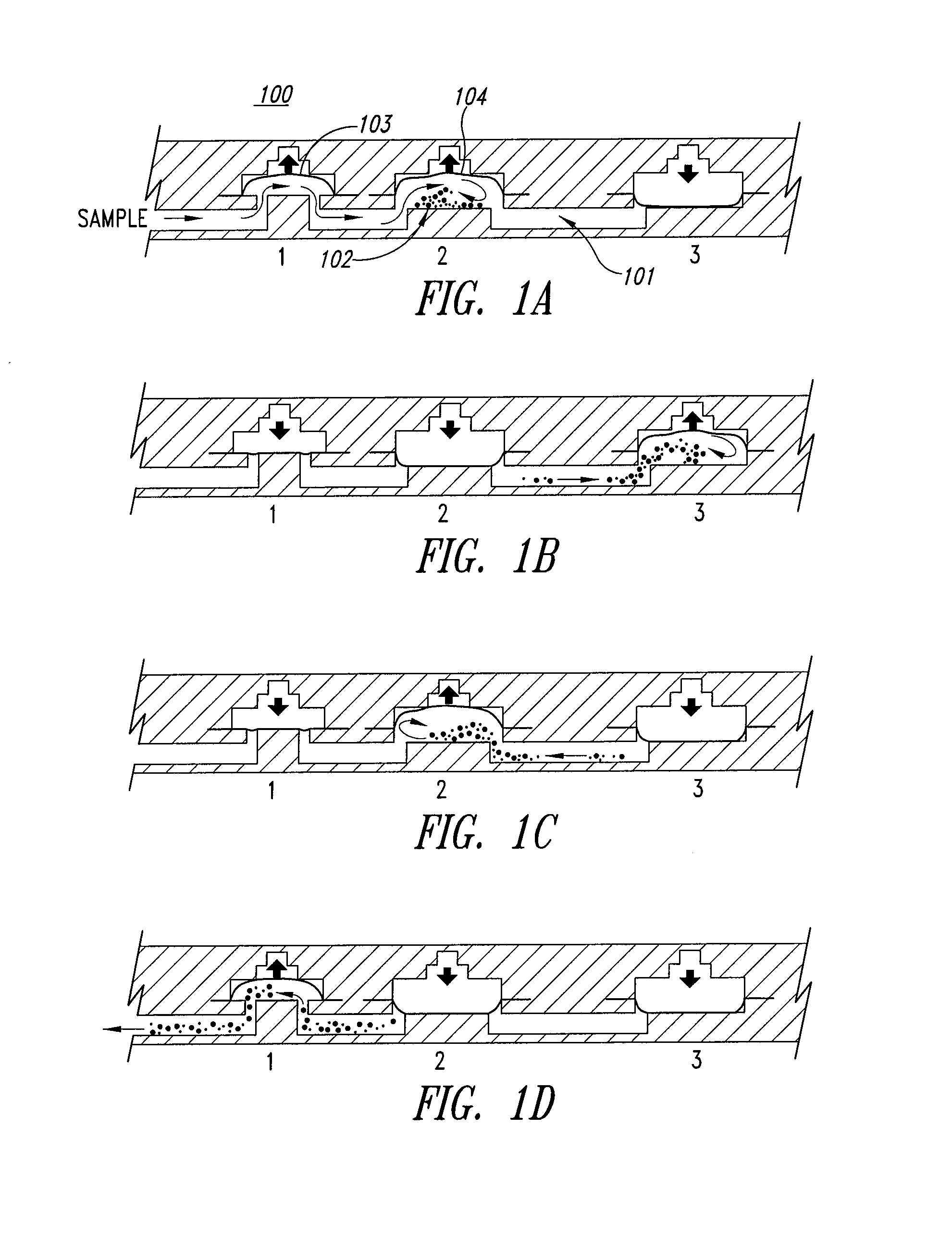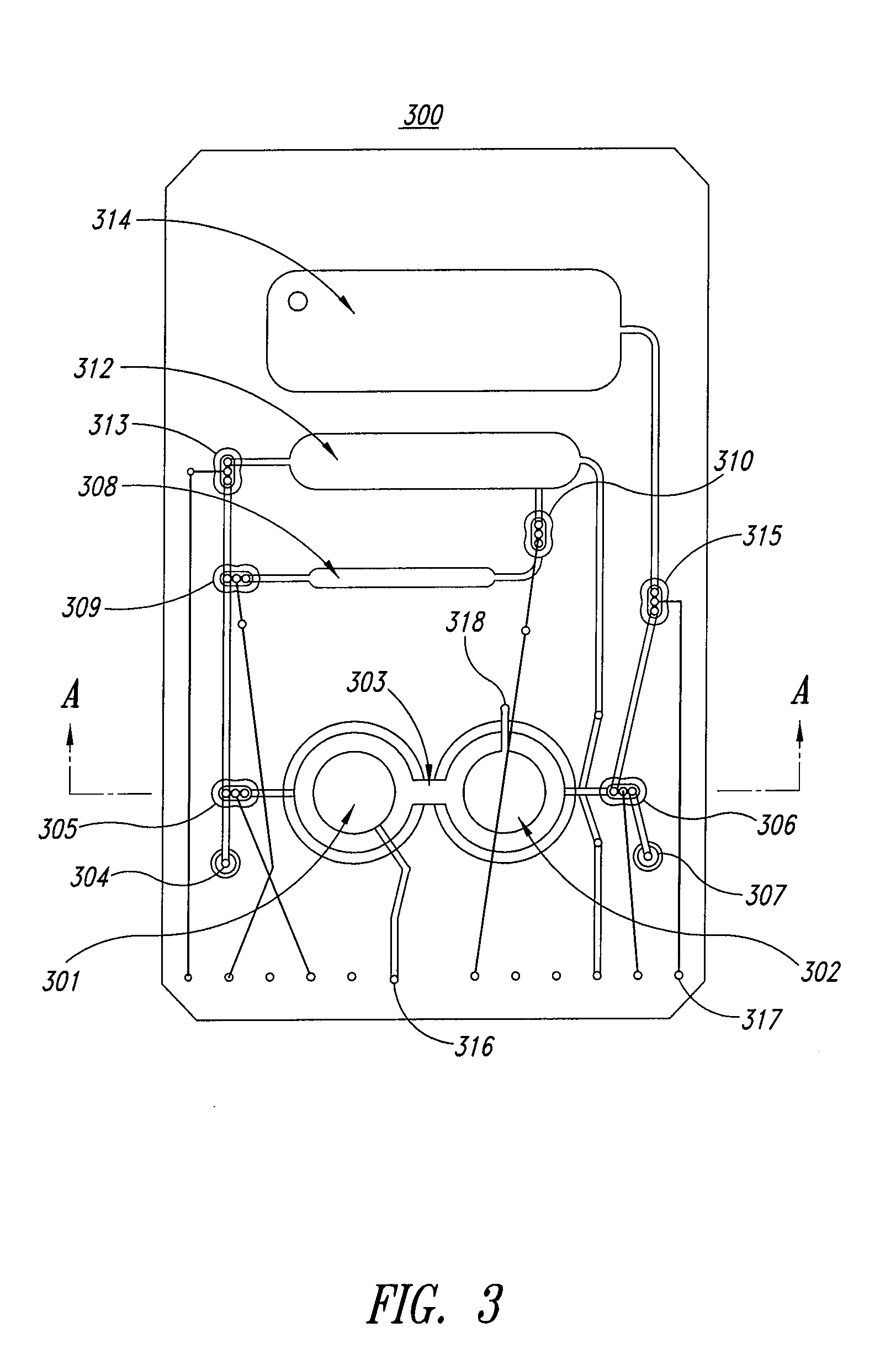Microfluidic mixing and analytical apparatus
a technology of microfluidic mixing and analytical equipment, which is applied in the direction of laboratory glassware, instruments, process and machine control, etc., can solve the problems of inability to efficiently automate and integrate methods, inability to meet the needs of automation and integration, and limitations of their use,
- Summary
- Abstract
- Description
- Claims
- Application Information
AI Technical Summary
Benefits of technology
Problems solved by technology
Method used
Image
Examples
example 1
Transition to Turbulent Flow
[0120]A classical way to detect the pipe-flow transition for a fluid is to inject a stream of dye into the moving fluid and to observe the wavering of the dye stream as it flows down the pipe. In the present experiment with particles, direct visualization of particle motion is also a very straightforward way of observing laminar flow and turbulence. Motion in the laminar regime is characterized by parallel particle trajectories, and motion in a turbulent transitional “puff” represents strong mixing in the radial direction. Similar observations can also be made as laminar flow breaks up as fluid exits from a pipe into a bulk fluid receiving vessel.
[0121]Flows in microfluidic structures are laminar and allow mixing by diffusion along boundary layers and interfaces (a phenomenon described in detail in U.S. Pat. No. 5,972,710 to Wiegl and co-assigned). However, such phenomena present a problem in microfluidic devices where bulk mixing or comminution of a samp...
example 2
CD45 Depletion Using a Dual Bellows Mixing Device
Experimental Cartridge Protocol:
[0132]White cells were isolated from blood 5 mL with a 5 min room temperature lysis using Gentra RBC lysis solution. After two washes with phosphate buffered saline (PBS) the white blood cell (WBC) pellet was resuspended in 1 ml of PBS. About 10,000 SW480 cells (Cd45+) in 100 uL buffer were added to 100 ul of the resuspended WBC pellet and the mixture was transferred to a dual bellows mixing cartridge of the present invention. All reagents and apparatus were chilled to 4° C. for the experiment. CD45 affinity capture magnetic beads 100 uL (Dynal MyOne®, Cat No. 111.53, 4×108 beads / mL) were then added. Bead population in the mixer was thus about 4×107 beads in a volume of 200 uL, with a cell:bead ratio of about 1:4000. The sample:bead suspension was mixed for four minutes using an automated apparatus compatible with the cartridge. A magnet was applied to the cartridge to trap the beads and the depleted fl...
example 3
Capture of E COLI with O157:H7 Serotype-Specific Antibody
Affinity Capture Bead Preparation:
[0135]Dynal MyOne® Tosylactivated beads were obtained from the manufacturer (Dynal ASA, Oslo Norway) and derivatized with Anti-O157:H7 antibody (US Biologicals, Swampscott Mass.) by the suggested protocol. Per 1 mg of beads, 40 mg of antibody was used. Bead diameter is 1.08 um.
Dual Bellows Pump Mixing and Capture Device Description:
[0136]The mixing and capture cartridge tested had three parallel dual bellows pump mixing devices and supporting fluidic circuitry, so that three experiments could be run side-by-side in the apparatus. Each mixing device was provided with a pipet port, a pair of bellows pumps with interconnecting aperture, a fill port for magnetic beads, and pneumatic pulse actuation ports for the mixing chamber and valves. The device was placed into a microFlow™ manifold (Micronics, Inc. Redmond Wash.) apparatus so that the microfluidic valves and actuation lines could be controlle...
PUM
| Property | Measurement | Unit |
|---|---|---|
| size | aaaaa | aaaaa |
| size | aaaaa | aaaaa |
| size | aaaaa | aaaaa |
Abstract
Description
Claims
Application Information
 Login to View More
Login to View More - R&D
- Intellectual Property
- Life Sciences
- Materials
- Tech Scout
- Unparalleled Data Quality
- Higher Quality Content
- 60% Fewer Hallucinations
Browse by: Latest US Patents, China's latest patents, Technical Efficacy Thesaurus, Application Domain, Technology Topic, Popular Technical Reports.
© 2025 PatSnap. All rights reserved.Legal|Privacy policy|Modern Slavery Act Transparency Statement|Sitemap|About US| Contact US: help@patsnap.com



